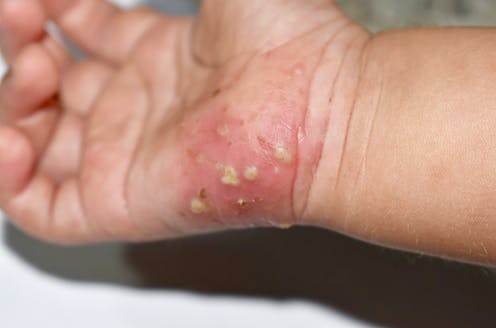Scabies is an unpleasant skin infection that’s common all around the world. Outbreaks happen regularly – with an estimated 450 million cases occurring globally each year. But since the start of winter, outbreaks in the UK have been higher than normal. In November 2023 alone, cases were double the seasonal average.
While there a probably a few factors that can explain this spike, treatment shortages appear to be at the heart of it.
Scabies is transmitted by mites. Mites are a type of ectoparasite that cause disease in humans. They’re similar to head lice but smaller in size. They burrow under the skin and reproduce by laying eggs that produce more mites.
The infection is spread through close contact with the mites. This can happen through skin-to-skin contact with an infected person, as well as contact with bedding, clothes or soft furniture used by someone who has scabies.
Symptoms of scabies usually arise around a month to six weeks after infection. Initial signs can often by quite subtle – such as a rash or small sores between the fingers. This rash can also spread to other parts of the body, including around the wrists and waist, groin or under the arms. The rash can be very itchy, especially at night.
More severe cases are often referred to as crusted scabies, where there may be hundreds of mites as opposed to the 10-20 mites in typical cases of scabies. The skin rash is also more severe, with a crust over the surface of the infected area. Crusted scabies usually occurs in people who have a weaker immune system.
Both typical and crusted scabies can lead to other skin infections, such as impetigo. It can also result in renal complications, including chronic kidney disease.
In the UK, scabies is typically treated using permethrin, a skin cream that needs to be rubbed all of the infected person’s body to kill all the mites and eggs. A second line of treatment is malathion, also a skin lotion. They are typically effective if applied properly. Two applications of the lotion, seven days apart, are usually recommended. Itching may take up to a month to completely subside after treatment.
Outbreak causes
Scabies is a disease of overcrowding. This means mites spread more easily in places where people come into close contact with each other for extended periods of time – such as schools, universities and prisons.
Residential care and nursing homes are particularly high-risk settings for scabies outbreaks, with vulnerable populations and staff members alike at risk of infection.
While contact tracing visitors and people who came in close contact with an infected person can reduce severity of outbreaks, this is extensive and time-consuming – and can be a significant strain on public health resources.

Scabies is transmitted by mites. Aliaksei Marozau/ Shutterstock
Another factor in the outbreak could be stigma against having scabies, with many people claiming the disease is caused by being unclean or a lack of bathing. In reality, there’s no good evidence about a lack of washing being a risk factor. But this stigma may prevent people from seeking help.
While some evidence suggests that scabies incidence is higher in the winter, in reality outbreaks can happen at any time of the year. As such, it appears the biggest factor in the spike in scabies cases is treatment shortages.
Since September 2023, there’s been a shortage of both permethrin and malathion in the UK due to supply issues. While scabies is curable, without treatment mites can continue to lay eggs and reproduce. This means any infected patients can continue to transmit the mites to other people. It remains to be seen whether these supply issues have been resolved.
Another option for treatment is ivermectin. Ivermectin previously made the news during the pandemic when it was wrongly thought to be a treatment for COVID-19, although research now shows there’s no good evidence to support these claims.
Ivermectin is an anti-parasitic drug and is recommended by the World Health Organization as a scabies treatment. However, it’s not licensed in the UK for scabies treatment, despite good data of its effectiveness and safety – though there is occasional off-license use.
The UK Health Security Agency actually suggests ivermectin can be used to manage outbreaks in situations where there are problems delivering other scabies treatments. Arguably, the supply issues we’re currently seeing with other treatments could be a reason to begin using ivermectin to reduce the number of cases in the UK.
Preventing infection
There are many things we can all do to reduce our risk of catching and spreading scabies.
If anyone has symptoms that might be scabies or another skin infection, such as itching and a rash or skin wounds, these should be reported to a doctor or healthcare provider as early as possible. This is especially important if they have potentially been in close contact with a known case.
If you have scabies or have come into contact with someone who does, you should wash clothes and bedding at 60°C or higher. Anything that cannot be washed should be put into plastic bags for at least four days to contain the mites until they die.
Scabies outbreaks can be brought under control – but diagnosis and treatment as early as possible is required for that to happen. Treatment shortages will only prolong the symptoms experienced by the patients, and increase risks of transmission. Increasing medication supply to meet demand is important, and the use of other effective medicines – such as ivermectin – should be considered.



 Eli Lilly’s Inluriyo Gains FDA Approval for Advanced Breast Cancer Treatment
Eli Lilly’s Inluriyo Gains FDA Approval for Advanced Breast Cancer Treatment  U.S. Experts to Reassess Newborn Hepatitis B Vaccination Guidelines Amid Growing Debate
U.S. Experts to Reassess Newborn Hepatitis B Vaccination Guidelines Amid Growing Debate  Novo Nordisk and Eli Lilly Lower Prices for Weight-Loss Drugs Amid U.S. Agreement
Novo Nordisk and Eli Lilly Lower Prices for Weight-Loss Drugs Amid U.S. Agreement  Trump and Merck KGaA Partner to Slash IVF Drug Costs and Expand Fertility Coverage
Trump and Merck KGaA Partner to Slash IVF Drug Costs and Expand Fertility Coverage  U.S. Backs Bayer in Supreme Court Battle Over Roundup Cancer Lawsuits
U.S. Backs Bayer in Supreme Court Battle Over Roundup Cancer Lawsuits  Trump Administration to Launch Autism Initiatives Targeting Acetaminophen Use and New Treatment Options
Trump Administration to Launch Autism Initiatives Targeting Acetaminophen Use and New Treatment Options  U.S. and Rwanda Sign $228 Million Health Partnership to Boost Self-Reliance
U.S. and Rwanda Sign $228 Million Health Partnership to Boost Self-Reliance  FDA Adds Fatal Risk Warning to J&J and Legend Biotech’s Carvykti Cancer Therapy
FDA Adds Fatal Risk Warning to J&J and Legend Biotech’s Carvykti Cancer Therapy  China to Add Eli Lilly’s Mounjaro to National Health Insurance in 2025
China to Add Eli Lilly’s Mounjaro to National Health Insurance in 2025  Trump Backs Review of U.S. Childhood Vaccine Schedule After Hepatitis B Policy Change
Trump Backs Review of U.S. Childhood Vaccine Schedule After Hepatitis B Policy Change  Pfizer Boosts Bid for Metsera Amid Intensifying Rivalry with Novo Nordisk in Obesity Drug Market
Pfizer Boosts Bid for Metsera Amid Intensifying Rivalry with Novo Nordisk in Obesity Drug Market  Eli Lilly’s Weight-Loss Pill Nears Fast-Track FDA Approval as Profits Surge on Global Demand
Eli Lilly’s Weight-Loss Pill Nears Fast-Track FDA Approval as Profits Surge on Global Demand  Merck Nears Acquisition of Cidara Therapeutics at Significant Premium
Merck Nears Acquisition of Cidara Therapeutics at Significant Premium  Novo Nordisk Appoints Greg Miley as Global Head of Corporate Affairs Amid U.S. Pricing Pressure
Novo Nordisk Appoints Greg Miley as Global Head of Corporate Affairs Amid U.S. Pricing Pressure  California Jury Awards $40 Million in Johnson & Johnson Talc Cancer Lawsuit
California Jury Awards $40 Million in Johnson & Johnson Talc Cancer Lawsuit 
































